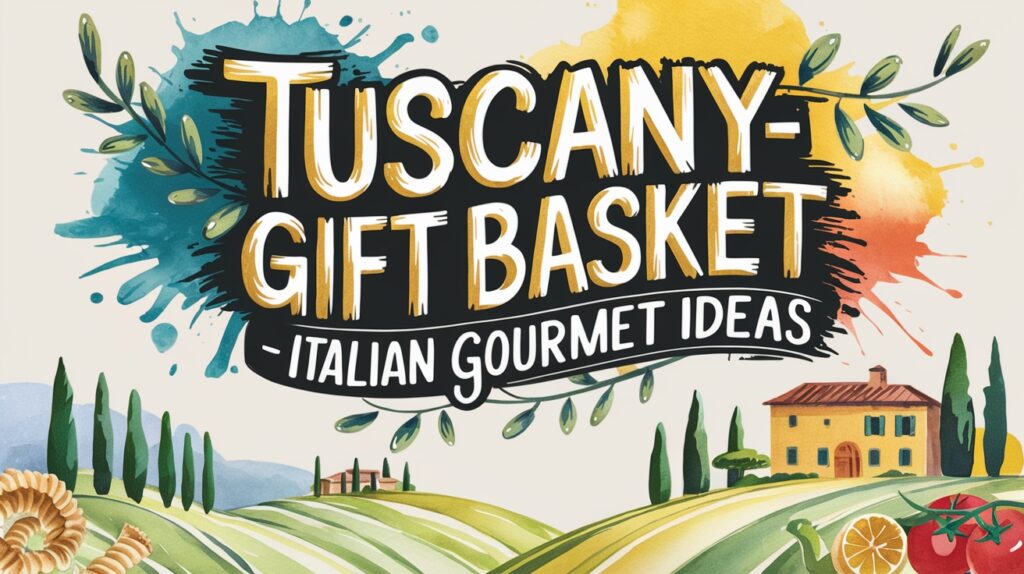A Tuscan gift basket brings Italy’s rich flavors right to your doorstep.
From wine to cheese, each item reflects the region’s food culture and traditions.
Simple ingredients combined thoughtfully create an authentic Mediterranean experience.

Key Takeaways
- Wine & Cheese Basket: Classic Chianti wine, firm Tuscan cheese, crisp biscotti
- Cooking Basics Basket: Extra virgin olive oil, pasta, tomatoes, seasoning mix
- Meat & Cheese Box: Cured ham, salami, aged pecorino in wooden container
- Sweet Treats Bundle: Almond cookies, spiced fruit cake, honey biscuits in clay basket
- Tuscany Pantry Basket: Dried mushrooms, marinated vegetables, cooking herbs
Essential Tuscan Pantry Staples to Include
A proper Tuscan pantry starts with these key staples. Good olive oil is the base ingredient, while pasta like pici and pappardelle represent local traditions. Porcini mushrooms, sun-dried tomatoes, and fennel seeds add flavor depth. Complete the basics with jarred vegetables in oil (sottoli) and common herbs like rosemary and sage from the region.
Sweet Treats and Confections From the Region
Tuscany offers distinctive confections perfect for gift baskets.
| Sweet Treat | Description |
|---|---|
| Cantucci | Crisp almond biscotti for dipping |
| Ricciarelli | Soft almond cookies with powdered sugar |
| Panforte | Rich fruit and nut cake |
| Cavallucci | Holiday cookies with nuts and fruit |
| Castagnaccio | Chestnut cake with pine nuts |
These sweets represent local baking traditions using basic regional ingredients.
Wine and Beverage Pairings
Tuscan wine makes perfect companions for local foods in gift baskets. Add a bottle of Chianti Classico red wine to pair with cheese and meats, or pack a Vernaccia di San Gimignano white wine for a fresh option.
For non-wine choices, include limoncello or local coffee. A bottle of Tuscan olive oil adds value to the basket. Pack all bottles with protective material for safe shipping.
Artisanal Cheeses and Cured Meats
Italian cheeses like pecorino, Parmigiano-Reggiano, and ricotta pair well with local cured meats including fennel salami, Tuscan ham, and boar sausage. These products complement wines and offer an authentic taste of Tuscany.
Popular Tuscan Cheese Varieties
Tuscan cheeses stand among Italy’s finest dairy products. The sheep’s milk Pecorino Romano offers a sharp, salty taste ideal for grating, while Ricotta Salata provides a mild, firm texture suitable for both cooking and direct consumption.
These cheeses reflect the traditional methods used by local shepherds in the Tuscan countryside, making them authentic regional specialties.

Artisanal Meats Selection Guide
Tuscan artisanal meats make practical additions to gift baskets. Local prosciutto brings a balanced salt-sweet taste, while fennel salami (finocchiona) pairs well with basic mortadella. Crumbly wine-spiced salami (sbriciolona) and boar sausage round out a solid meat selection that represents the region well.
Perfect Pairing Suggestions
Classic Italian cheese and meat combinations enhance any gift basket. Pair aged Pecorino with Prosciutto Toscano alongside a glass of Chianti. Match soft Stracchino cheese with Finocchiona salami for a balanced taste. Fresh Mozzarella works well with Mortadella, complemented by Vernaccia white wine. Gorgonzola and Capicola create a strong flavor profile. Include basic serving tips with each pairing to guide recipients through these regional combinations.
Decorative Elements and Packaging Tips
A well-presented Tuscany gift basket stands out with thoughtful packaging. Use simple baskets, wooden boxes, or crates that match the region’s style. Choose earth tones like olive green, terra cotta, and wine red for the color scheme.
Finish with basic brown paper, string ties, and fresh herbs. Add small touches like Italian flags, recipe cards, or tags with Italian words. Wrap in clear wrap and top with a neat bow.
Seasonal and Special Occasion Variations
Customize Tuscany gift baskets according to the season or occasion. For winter, add red and green ribbons with panettone. Spring baskets can include local flowers and Easter candy. Summer options feature lemonade and dried tomatoes, while fall baskets showcase truffles and harvest items.
For special events, match contents to the occasion – wine glasses for weddings, birthday cards with Italian greetings, or holiday-specific treats. Each basket reflects both the timing and Tuscan traditions.












